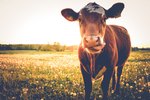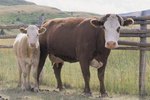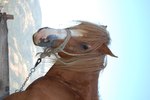Stopping diarrhea -- referred to as scours -- in cattle depends on the cause of the illness. Your veterinarian can diagnose the viral, bacterial or protozoal agent causing the scouring by means of a fecal sample. This is helpful not only for identification purposes, but for establishment of a prevention program to eliminate or lessen future scouring episodes. If your cow experiences mild diarrhea, give her kaolin or a similar product as directed on the bottle. If the diarrhea doesn't clear up within a day of treatment, call your vet.
Calf Scours
Calf scours generally occur within the animal's first month of life, with most occurring from the third to 16th day after birth. A calf might lose up to 6 percent of his bodily fluids before symptoms appear. Symptoms include yellowish, green or grayish watery feces, often containing mucus or blood. The affected calf may stop nursing, and appear depressed. He might seem unsteady on his feet, with a sunken-eyed look from dehydration and low blood sugar. He may go down from weakness. Without immediate treatment, he may die within 24 hours.
Calf Scours Treatment
A scouring calf requires electrolyte therapy. Don't use the same electrolytes you give your stock for general supplementation. Electrolytes for scours treatment consists of an oral rehydration solution, consisting primarily of water. Other ingredients include sodium, glucose, glycine and alkalinizing agents, with some solutions also containing microbials to improve gut health and gelling agents.
In an emergency, you can make your own oral rehydration solution. Penn State Extension recommends a formula consisting of 1 teaspoon low sodium salt, 2 teaspoons baking soda, one packet of fruit pectin and one can of beef consomme added to 2 quarts of water. This should be fed at a rate of 1 pint for every 10 pounds of the calf's body weight, three to four times daily. With commercial or homemade oral rehydration formulas, it's better to give the calf too much rather than too little.
Salmonella in Cattle
In older cattle, salmonella is among the most frequent causes of scouring. It's also a bacteria easily transmitted to people, so wear gloves when handling any cattle with scours. Grown cows suffering from salmonella experience especially bad-smelling, often bloody diarrhea, often accompanied by a fever. The feces might also contain a yellow substance, called fibrin, from the intestine. Even with prompt and aggressive treatment, many animals do not survive a salmonella infection. The cow requires oral or intravenous rehydration therapy, along with anti-inflammatories for fever reduction and appropriate antibiotics. This is definitely a situation in which your veterinarian must be involved.
Winter Dysentery
Milk cows might experience winter dysentery, in which watery diarrhea appears and milk production drops profoundly. The feces might contain mucus or blood, and are generally dark. Affected cows also might suffer from a cough or eye discharge. Fortunately, most cows recover within a few days, but severely affected animals may need intravenous fluid therapy or even a blood transfusion.
References
- Penn State Extension: Electrolytes for Dairy Calves
- Merck Veterinary Manual: Intestinal Diseases in Cattle
- Colorado State University Veterinary Extension: Calf Scours 101 -- Basics of Calf Diarrhea for the Beef Cattle Producer
- The Dairyman: 0608 EL -- Diarrhea in Cows and Calves
- Dalehead Veterinary Group: Scouring Calves – Factsheet
- Drugs.com: Kaolin-Pectin
Photo Credits
-
Anup Shah/Digital Vision/Getty Images
Writer Bio
Jane Meggitt has been a writer for more than 20 years. In addition to reporting for a major newspaper chain, she has been published in "Horse News," "Suburban Classic," "Hoof Beats," "Equine Journal" and other publications. She has a Bachelor of Arts in English from New York University and an Associate of Arts from the American Academy of Dramatics Arts, New York City.





